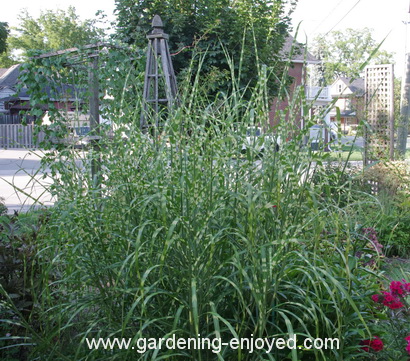
Perennial grasses are wonderful additions to the garden and autumn is their time to show off. Many of them will produce a wonderful inflorescence that becomes a treasure trove of seeds to feed the birds during the winter. This large clump of Zebra grass Miscanthus sinensis ‘Zebrinus is lighting up the front garden right now and should start to throw its inflorescence any day now. I attacked this clump early in the spring and removed over half of it and it showed no ill effects. In fact it seems to be as big as it was last year. I moved a couple of the pieces that I dug up, to the back yard along the fence and they both appear to be alive, one more so than the other, but neither of them are anywhere near the size of this one. By the time it has finished flowering this mature piece will probably be well over 2.5 m tall. I will leave it all winter and cut it to the ground before it starts to sprout next spring. The big question is whether I again remove some of it
or just let it take all the space it wants. It’s crowding the Rhubarb in front of it.
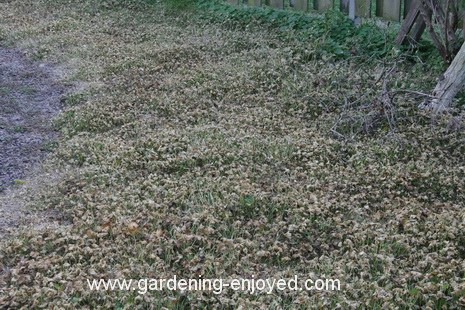
Creeping Charlie, Ground Ivy, Glechoma hederacea or several unprintable names are applied to this invasive member of the mint family. It loves to take over areas of turf and it will survive and stay green when the drought has completely devastated the lawn. The very dead looking plants here, have been sprayed with 10% vinegar which takes the foliage off, like this, in a few hours. If you look closely, the green, ground level stolons that give it its “creeping” name still appear to be a bit green. I plan to rake it with a stiff toothed rake to remove as much as possible. I may give it another shot of the vinegar first to get the spots I obviously missed and to try and dry out those stolons. As the weather cools and starts to get a bit more moisture, it is the perfect time to overseed this area with lots of grass seed. This is just another in my string of efforts to eradicate the Ground Ivy. It stayed a nice rich green during the worst of this summer’s drought
and heat, it spreads rapidly and even has a nice blue flower, maybe I should just give in and let it be my new lawn. If it would just stop at the edge of the flower and vegetable beds I might consider it.
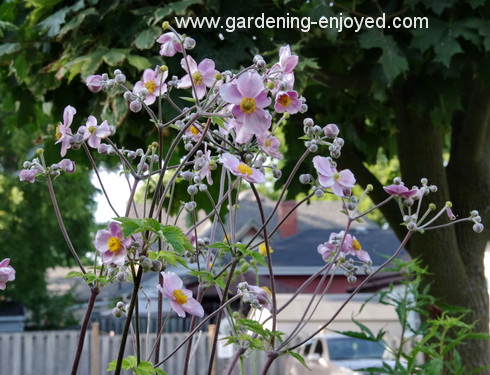 Here is another of my love/hate relationships. At this time of year the Japanese Anemone, Anemone hupehensis, or windflower can be seen standing above all of the other perennials in my garden and the delicate pink flowers on long stems are gently moving with the wind, providing its common name. I admit to enjoying them right now except that I have fastidiously dug them out of that bed, at least twice. The smallest piece of their, very deep, roots left behind will quickly populate a fresh new stand of them. If they stayed in a nice, well behaved, clump I would be glad to have them. They don’t. In just a few seasons they will be popping up all over this large bed easily crowding out many less aggressive and usually more desirable, species. I’ll be digging again this year or maybe breaking a law or two by carefully painting their leaves with an effective chemical that is not licensed for that application.
Here is another of my love/hate relationships. At this time of year the Japanese Anemone, Anemone hupehensis, or windflower can be seen standing above all of the other perennials in my garden and the delicate pink flowers on long stems are gently moving with the wind, providing its common name. I admit to enjoying them right now except that I have fastidiously dug them out of that bed, at least twice. The smallest piece of their, very deep, roots left behind will quickly populate a fresh new stand of them. If they stayed in a nice, well behaved, clump I would be glad to have them. They don’t. In just a few seasons they will be popping up all over this large bed easily crowding out many less aggressive and usually more desirable, species. I’ll be digging again this year or maybe breaking a law or two by carefully painting their leaves with an effective chemical that is not licensed for that application.
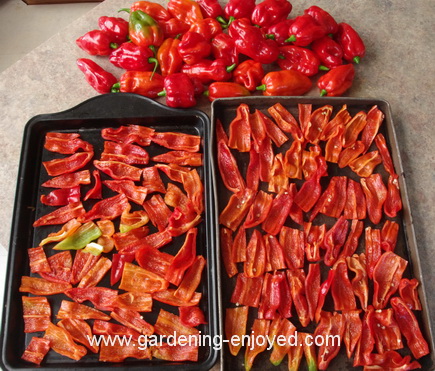
A few of my Peppers did really well this year leaving us with an abundant harvest. We have eaten them almost every day in many forms and they have gone into a few of the frozen meals, such as the Spaghetti Sauce and still we have a surplus. Here we have seeded them and cut them into big flat chunks and will freeze them on these cookie sheets, so that they are separate pieces and then we can bag them for use all winter in stir fries or similar recipes. The big secret is to make sure they are dry so that they remain as separate pieces in the freezer bag.
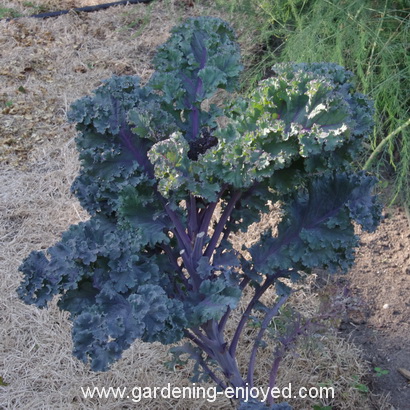
I hate to admit that I’ve never understood why vegetable gardeners would grow Kale? ☺ I grew this one because the All America Selections people sent it to me to trial. It is very decorative and maybe deserves a spot in the ornamental garden. As we were looking for recipes to make and freeze for the winter, I looked particularly for recipes using Ricotta cheese because I had purchased too much of it for my Moussaka recipe. Stuffed Cannelloni caught my attention. It asked for the Ricotta to be mixed with frozen chopped spinach. I didn’t have any Spinach but I did have an excess of Swiss Chard and this Kale. Why not try a substitution. I cut out the heavy central veins of both and then poured some boiling water over them to wilt them. They got mixed with the Ricotta and stuffed into the Cannelloni shells and cooked in a Marinara sauce that used up a good quantity of our excess tomatoes. It was delicious. The Kale and Swiss Chard are still thriving in these cooling
autumn days so I will need to buy some more Ricotta cheese and, just maybe, add Kale to my regular vegetable garden list or more likely I’ll use this variety and keep it where it’s decorative appeal makes it a multi use addition to the garden. Never too old to learn new things!
To ask a question just “reply” to this ezine. Don’t forget to check the front page of the Website for frequent short ideas for current gardening activities.
|

 Here is another of my love/hate relationships. At this time of year the Japanese Anemone, Anemone hupehensis, or windflower can be seen standing above all of the other perennials in my garden and the delicate pink flowers on long stems are gently moving with the wind, providing its common name. I admit to enjoying them right now except that I have fastidiously dug them out of that bed, at least twice. The smallest piece of their, very deep, roots left behind will quickly populate a fresh new stand of them. If they stayed in a nice, well behaved, clump I would be glad to have them. They don’t. In just a few seasons they will be popping up all over this large bed easily crowding out many less aggressive and usually more desirable, species. I’ll be digging again this year or maybe breaking a law or two by carefully painting their leaves with an effective chemical that is not licensed for that application.
Here is another of my love/hate relationships. At this time of year the Japanese Anemone, Anemone hupehensis, or windflower can be seen standing above all of the other perennials in my garden and the delicate pink flowers on long stems are gently moving with the wind, providing its common name. I admit to enjoying them right now except that I have fastidiously dug them out of that bed, at least twice. The smallest piece of their, very deep, roots left behind will quickly populate a fresh new stand of them. If they stayed in a nice, well behaved, clump I would be glad to have them. They don’t. In just a few seasons they will be popping up all over this large bed easily crowding out many less aggressive and usually more desirable, species. I’ll be digging again this year or maybe breaking a law or two by carefully painting their leaves with an effective chemical that is not licensed for that application.


